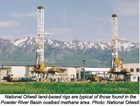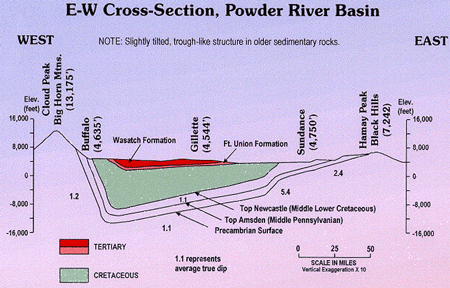Coalbed methane gas production soars in Wyoming's Powder River Basin
 Recovery estimates for current plays were made when gas was selling for about half what it is today and are certain to be revised upward dramatically
Recovery estimates for current plays were made when gas was selling for about half what it is today and are certain to be revised upward dramaticallyBy John Murphy, Houston
Just a few years ago, exploration and production companies, battered by a combination of low commodity prices, high finding costs, and lack of infrastructure, were leaving the US Rocky Mountains in droves. Even now, traditional oil and gas drilling in the once robust area remains a shadow of its late-1970s pinnacle when companies like Phillips, Amoco, and Exxon had a standing offer of work in southwestern Wyoming to all rigs capable of drilling beyond about 14,000 ft.
But the gas drilling industry has been given a new life recently, albeit in a form not easily recognized by the engineers who exploited the deep gas of the area known as the Overthrust Belt and other formations of Wyoming, North Dakota, Colorado, and Utah. Today gas is being pulled from Rocky Mountain wells drilled to depths of only 300 ft to 2,000 ft. To traditional oil men, the numbers associated with these wells are almost disorienting. Wells are drilled with small rigs more suitable for drilling water wells. They reach total depth in less than a day and are usually cased, cemented, and completed within two more days. And companies like Pennaco Energy, established in 1998 and already one of the most active in the play, number the wells they plan to drill during each of the next few years in the thousands.

"A typical well is from 400 to 1,000 ft," said Pennaco operations supervisor, Stan Dudley. "We anticipate as we move west they will go to 1,500 to 1,600 ft and by the end of (2000), we should have drilled about 1,200 wells in a year and a half."
The wells are simple from a drilling standpoint, said Jay Beach, current general manager of Key Rocky Mountain drilling contractor who has spent the past 25 years drilling in the Powder River Basin and elsewhere in the Rockies.
"Pennaco and others drill an 8.75- or 9.875-in. hole to the top of the coal, set casing and cement to the surface," Beach said. "Then we drill a 6.25-in. hole to the bottom of the coal and under ream."

Under reaming, generally to a bore size of 10.5-in to 14-in., is done to increase the surface area from which water and gas can flow into the wellbore. The well is then completed with an electrical submersible pump (ESP) at the end of 2.375-in. tubing, most often made of plastic. The configuration, while simple and fast, serves a dual purpose of "de-watering" the well and forming a downhole water-gas separator.

The ESP is at the heart of the science that has brought coal bed methane production from the fringes to the mainstream of the gas E&P industry. That is because the key to producing gas from coal beds is removal of water trapped in the coal cleats, small fissures in the fragmented coal. It is the pressure of the in-situ water that holds the gas in place. But it is not a straight forward a proposition of merely flowing all the water to the surface.
"In some cases you must have a certain amount of pressure to keep the cleats open," Dudley said. "So you have to find the optimum [water level] that we call the ‘sweet spot'. You have to play with it by taking water off to bring the pressure down, but if you go too far you have to set a back pressure valve and then let the water come back in [to the formation]. Each well is different. Sometimes you have to take the water level down 20 ft, sometimes you have to hit 100 ft."
CBM wells produce water over the course of their life though reaching the sweet spot, otherwise called ‘de-watering', can take anywhere from a matter of weeks in shallow wells to years in deeper ones.
"In 1989, I was on [CBM] projects in Colorado and Utah that were in much deeper coals, and it took several years to de-water those," Dudley said. "But [in the Powder River Basin] it is two to three weeks on some and five to six months on others."

The standard configuration—an ESP on tubing in an open hole through the coal with a cased hole upper hole—allows the well to act as a natural gravity gas-water separator wherein gas flows up the annulus and water is pumped through the tubing to the surface. That the coal can be drilled and left open hole is also a great money saver that has pleasantly surprised some operators who expected trouble from such shallow, essentially unconsolidated formations.
"We do set some slotted liners to handle the [coal] fines in some wells, since coal is pretty unconsolidated," Dudley said. "But normally we just go back in and clean fines out in some of the problem wells and eventually they just stop coming."
One reason the Powder River Basin play has become so hot is that the water is mostly sweet and can be discharged to surface holding tanks. This saves a great deal of money on disposal wells that are as expensive to drill and operate as production wells and greatly enhances the play's economics.

Also, the water's high quality and the trapping mechanism that assures it is not connected to local water sands alleviates major environmental concerns that have hindered CBM development in other parts of the country. In the Basin, for example, some coalbed water is reportedly of such high quality that when pumped into the Gillette, Wyoming city aquifer it actually improves the aquifer's overall quality. Likewise, industry studies indicate that within five years, 90% of all water removed from the coal beds during production will be naturally replaced.
Beach, whose company has two rigs running in the Powder River CBM play full time with plans to add two more soon, agrees with industry cost estimates that place the cost of a CBM well in the area, from spud to production, at about US$75,000 per well. And, he says, while CBM drilling and completion is sufficiently young to encourage experimentation by operators seeking better or faster drainage, it is imperative they continue to go with what they know and change only with care.
"There is a lot of experimenting going on by people looking for the best way to drill and complete these wells," he said. "We ran an eight-ft diameter under reamer. It took us two days to get it done. With the way these wells pay out, that means some time to recoup those costs.
"I am not saying don't try things. But if you ream out to say 12.5 in. and see how that produces and then try a 21-in. that makes sense. But the key to making money on this play is to keep costs down and that means time."
One technology whose application to CBM production has been the subject of a great deal of speculation and experimentation in the past is hydraulic fracturing. Today it is common to simply pump a small amount of water under low pressure into the hole before setting the ESP and production tubing. But while technically it is a fracture treatment, it is done more to remediate drilling damage than as a stimulation treatment.
But in the late-1980s, one independent operator working in Wyoming conducted a series of high-volume, high-pressure fractures including the use of proppant and gels, on a 30-well program in a deep coal play. They were trying to determine whether the effort was actually opening the rock or merely crushing it. Unfortunately, due to industry consolidation and technical factors affecting coal bed behavior that were poorly defined at the time, said a source involved with the program, the results of that early work was inconclusive.
Now however, as the industry moves to the west into deeper coal seams and armed with more knowledge of CBM behavior as a whole, hydraulic fracturing may be brought to bear. "In the deep and more compacted wells, we may be able to actually fracture the coals," said Dudley. "In the shallower wells a fracture tends to crush the rock rather than split it open."

Once gas begins to flow from the coal, it does so at a mind-boggling low pressure differential of about 2-psi. To enter commercial pipelines, then, the gas pressure must be raised to about 80-psi. Commonly, to minimize the number of compressor installations, individual CBM wells are first produced to pods, or gathering stations, before being sent to compressors. In other instances, due to the layout of the field and the accessibility of the commercial line, a single well may go directly to the screw compressor before entering the pipelines owned by the major buyers.
In either case, local CBM producers are already reporting bottlenecks at pipelines and compressor stations whose dimensions are being overwhelmed by greater than expected production numbers.
The Wyoming Oil & Gas Commission reported that by the end of 1999 more than 3,000 CBM wells had been drilled in the Powder River Basin with more than 2,000 of them done in 1999 alone. Some industry observers estimate that eventually more than 30,000 of these wells will be drilled in this one play, each with an average estimated ultimate recovery of more than 4 million cf of gas.
And there are several comparable plays throughout the west whose productivity levels will gain by the lessons being learned in northeastern Wyoming. In 1999, the US Geological Survey estimated that more than 50 trillion cf of coal bed gas was trapped in 5 million acres of coal in the USA.
Since ultimate recovery estimates for current plays were made when gas was selling for about half what it is today, that number is certain to be revised upward dramatically. And as the industry increases its own efficiencies and moves into more compressed, thicker, and therefore more prolific coal seems, it seems likely the market share for this relatively new source of energy will only grow.
